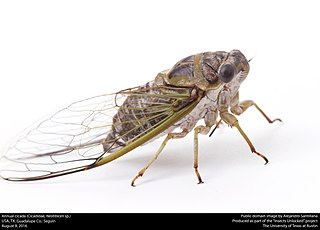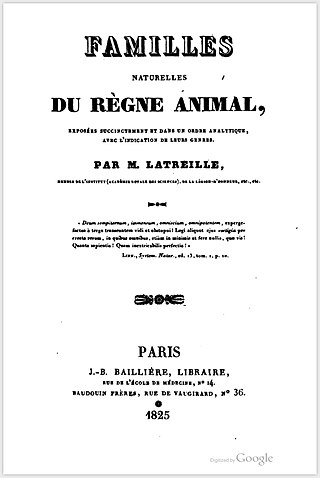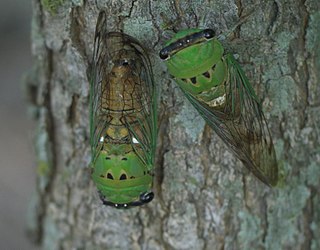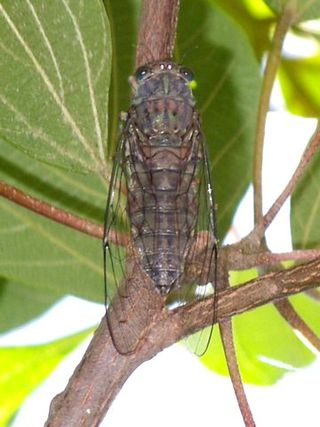
The cicadas are a superfamily, the Cicadoidea, of insects in the order Hemiptera. They are in the suborder Auchenorrhyncha, along with smaller jumping bugs such as leafhoppers and froghoppers. The superfamily is divided into two families, the Tettigarctidae, with two species in Australia, and the Cicadidae, with more than 3,000 species described from around the world; many species remain undescribed.

Cicadidae, the true cicadas, is the largest family of cicadas, with more than 3,200 species worldwide. The oldest known definitive fossils are from the Paleocene, a nymph from the Cretaceous Burmese amber has been attributed to the family, but could also belong to the Tettigarctidae.

Cicadas of the genus Neotibicen are large-bodied insects of the family Cicadidae that appear in summer or early fall in eastern North America and formerly Bermuda. Common names include cicada, harvestfly, jar fly, and the misnomer locust.

Gaeanini is a tribe of cicadas in the family Cicadidae, found in the Palearctic and Indomalaya. There are about 10 genera and at least 50 described species in Gaeanini.

Cryptotympanini is a tribe of cicadas in the family Cicadidae. They are found in the Nearctic, Palearctic, Indomalaya, Oceania, and Afrotropics.

The Fidicinini are a tribe of cicadas. There are at least 20 genera and 250 described species in Fidicinini, found in the Nearctic and Palearctic.

Neotibicen tibicen, known generally as the swamp cicada or morning cicada, is a species of cicada in the family Cicadidae. It is widespread across much of the eastern and central United States and portions of southeastern Canada. There are two subspecies, N. tibicen tibicen and N. tibicen australis, with the latter replacing subspecies tibicen in portions of Florida, Georgia, and Alabama.

The Dundubiini are a tribe of cicadas in the family Cicadidae, found in the Palearctic, Indomalaya, Australasia, and the Western Pacific. There are at least 180 described species in Dundubiini.

Tibicen is a historical genus name in the insect family Cicadidae that was originally published by P. A. Latreille in 1825 and formally made available in a translation by A. A. Berthold in 1827. The name was placed on the Official Index of Rejected and Invalid Generic Names in Zoology by the International Commission on Zoological Nomenclature in 2021. Certain European cicada species that were included by some authors in this genus at the time of its suppression are now listed under genus Lyristes Horváth, 1926. Other formerly-Tibicen species are placed in the tribe Cryptotympanini and include the genera Auritibicen Lee, 2015, Hadoa Moulds, 2015 Megatibicen Sanborn and Heath, 2016, and Neotibicen Hill and Moulds, 2015.

Tettigarcta is a genus of cicadas in the family Tettigarctidae. There are two described species in Tettigarcta, one found in mainland Australia and one on the island of Tasmania. These two species are the only living species of the family Tettigarctidae, the rest being extinct. They are around 3.5 to 4.5 centimetres in length. The species are active at night and are attracted to light, and rest under loose bark during the day. Unlike other cicadas, they do not make loud calls, but produce low intensity sounds transmitted through the substrate they are attached to, similar to other members of Auchenorrhyncha.

Megatibicen is a genus of cicadas in the family Cicadidae, with about 10 described species. Until 2016, these species were included in the genus Tibicen and then briefly in Neotibicen. The species formerly of genera Ameritibicen Lee, 2016 and Gigatibicen Lee, 2016 are now considered species of Megatibicen Sanborn & Heath, 2016.

Neotibicen davisi, known generally as the Davis' southeastern dog-day cicada or southern dog-day cicada, is a species of cicada in the family Cicadidae.

Neotibicen lyricen, the lyric cicada, is a species of cicada in the family Cicadidae.

Neotibicen pruinosus, commonly known as the scissor grinder, is a species of cicada in the family Cicadidae.

Neotibicen superbus, the superb dog-day cicada, is a species of cicada in the family Cicadidae. It is the greenest cicada in the neotibicen genus. It has reduced black patterning and looks different than most other cicadas in its genus. Its song is a soft buzz that reaches a crescendo.

Leptopsaltriini is a tribe of cicadas in the family Cicadidae. There are at least 200 described species in Leptopsaltriini, found in the Palearctic, Nearctic, and Indomalaya.

Macrotristriini is a tribe of cicadas in the family Cicadidae. There are at least 2 genera and 20 described species in Macrotristriini, all found in Australia.

Oncotympanini is a tribe of cicadas in the family Cicadidae, found in China and southeast Asia. There are at least 3 genera and about 12 described species in Oncotympanini.

Neotibicen winnemanna, commonly called the Eastern scissor(s) grinder, is a species of large bodied annual cicada in the genus Neotibicen. It is native to the Eastern United States, particularly the Piedmont Plateau and the outlying lower mountainous elevations of the Appalachians and inner, western portion of the Atlantic coastal plain.

Lyristes is a genus of cicadas from Europe and the Middle East. It was described by G. Horvath in 1926.


















